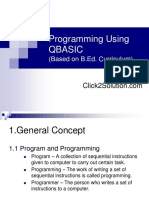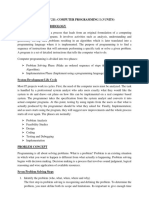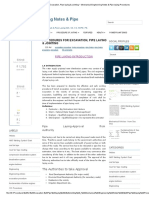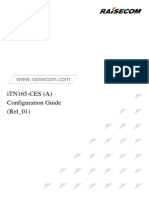0 ratings0% found this document useful (0 votes)
45 viewsSteps in Programme Development
The document outlines the key steps involved in program development, including problem identification, dividing the problem into subtasks, analyzing input and validating data, designing algorithms, coding, testing and debugging, and documenting programs. It also discusses various programming concepts like algorithms, programming languages, and approaches to testing programs. The overall process involves analyzing problems, designing solutions, implementing programs, removing errors, and documenting code for future use and modification.
Uploaded by
prashant sharmaCopyright
© © All Rights Reserved
Available Formats
Download as PPT, PDF, TXT or read online on Scribd
0 ratings0% found this document useful (0 votes)
45 viewsSteps in Programme Development
The document outlines the key steps involved in program development, including problem identification, dividing the problem into subtasks, analyzing input and validating data, designing algorithms, coding, testing and debugging, and documenting programs. It also discusses various programming concepts like algorithms, programming languages, and approaches to testing programs. The overall process involves analyzing problems, designing solutions, implementing programs, removing errors, and documenting code for future use and modification.
Uploaded by
prashant sharmaCopyright
© © All Rights Reserved
Available Formats
Download as PPT, PDF, TXT or read online on Scribd
You are on page 1/ 16
STEPS IN PROGRAM
DEVELOPMENT
Master School of Managemen
INTRODUCTION TO
PROGRAMMING LANGUAGE
Let us start with a simple problem:
To find the Addition of two
number
The steps are
Read the two numbers
Add these two numbers, producing
the sum
Print out the sum
PROGRAMMING LANGUAGE
Since the computer cannot understand
instructions in the English language
some special languages must be used
for writing the instructions. These
special languages are called
Programming Languages.
Instructions written in a programming
language constitute what is known as
a program.
The person who writes the program is a
programmer.
STEPS FOLLOWED WHEN
DEVELOPING PROGRAM
Problem identification.
Division of the problem into smaller part known
as tasks and the analysis of these tasks.
Analysis of the data and validation of the data
that will be used in the problem
Input/output specifications.
Design of the algorithm for the solution of the
problem.
Coding of the algorithm in a language
understood by a computer.
Implementation of the program, including
testing and debugging.
Documentation of the program.
Use of the program and possible modifications.
PROBLEM IDENTIFICATION
Need to be absolutely clear about
what the problem really is.
Have to identify and define
unambiguous terms in the problem.
Identify the root of the problem not
the symptom.
The problem has to be viewed in its
entirety and not in fragments.
TASKS AND TASKS
ANALYSIS
A programming problem (tasks) can almost
be broken into a number of sub-problems
(sub tasks).
It is because
Sub-task is always smaller than the original
task and hence easier to manage and
solve. (the principle of divide and
conquer)
The sub-tasks can be solved in parallel,
perhaps by assigning different sub-tasks
to different people.
DATA ANALYSIS AND DATA
VALIDATION
A program transforms input data into
output data. Data analysis starts with
reviewing the collected data. Finding
meaning in the data is very important.
Before settling down to write the code, we
must take a critical look at each and every
piece of data.
GIGO (garbage-in equals garbage-out) is the
fact. We get meaningful results from the
machine if and only if the input to the
machine is meaningful, and a wrong
(incorrect) data input produces nonsense
output. Hence data verification is
necessary.
INPUT / OUTPUT SPECIFICATIONS
Before coding the programmer must
be supplied with detailed input-
output specifications of the
program. There should be a precise
and unambiguous description of
What constitute the input data.
Format of the data
Physical medium of input
Format of the output.
Physical medium of output
DESIGN OF ALGORITHM
It is a set of instruction which, when
followed in a predetermined sequence,
leads to the solution of a given problem
in a finite number of steps.
An algorithm should satisfy the following
criteria:
There should be input (s).
There should be at least one output.
Each instruction should be unambiguous.
There should not be any uncertainty about
which instruction is to be executed next.
Algorithm should be terminate after a finite
number of steps.
Some of the tools of algorithm are
Flowchart, Pseudo code (P-Code), Data Flow Diagram. HIPO
Diagram
CODING
it refers to writing statements
according to the algorithm following
the syntax of the programming
language at hand. Of course the
right choice of the language for the
coding is an important issue.
IMPLIMENTATION OF PROGRAM
It is but natural to make mistakes in
programming. Before running the
program it is good practice to sit down
with a pencil and paper and trace the
execution of the program with some
sample data.
By a careful study of the programs the
syntax errors or/and semantic (logical)
errors can be detected.
Syntax errors are pointed out by the
computer and are thus easy to rectify.
But we cannot expect the computer to
catch semantic errors in our programs.
TESTING & DEBUGING
When the program has a logical
error, we say that it has a bug.
The rectification activity of bug
is known as debug.
Testing and debugging are not
same. Testing tells us the
existence of error(s) and
debugging is the process of
removing the error(s).
TESTING APPROACHES
Two types of approaches are applied to test a
program
Black box testing: also known as functional
testing, is a testing technique where the
tester never examine the project code and
does not need further knowledge of the
program other than its specifications. The
tester should only know about the inputs
and the expected outcomes.
White box testing: also known as glass
box, structural, clear box and open box
testing. Here explicit knowledge of the
internal workings of the item being tested.
PROGRAM DOCUMENTATION
Documentation is an integral part of the
program development process. It refers to all
written material that helps to explain the use
and maintenance of a system or program.
Proper documentation enables the user to
understand the program and acts as a
reference tool for programmers.
In case modifications are required, it is easier to
understand the logic of a program from
documented records rather than the code.
Documents for the users are system manuals,
user manuals, online help etc
Documents for developers are comments in the
program, visual appearance of code, various
reports, programming tools like algorithms,
flowcharts etc
USE AND MODIFICATION OF
PROGRAM
Programs, once developed, remain in
use for a period of time. And in future
modification of the program may
required due to
Change in external factors of
requirement of the program.
May have some bug in the program
found later while using it.
To improve the program.
?
Thank u
?
You might also like
- The Aircraft Environmental Flight EnvelopeNo ratings yetThe Aircraft Environmental Flight Envelope11 pages
- Instructional Module and Its Components (Guide) : Course Program Logic Formulation Developer and Their BackgroundNo ratings yetInstructional Module and Its Components (Guide) : Course Program Logic Formulation Developer and Their Background10 pages
- TOPIC 1 - An Overview of MS Visual Basic[1]No ratings yetTOPIC 1 - An Overview of MS Visual Basic[1]31 pages
- Hapter Ntroduction To Programming Concepts: Problem Solving With ComputersNo ratings yetHapter Ntroduction To Programming Concepts: Problem Solving With Computers10 pages
- Csc121 - Topic 2 Introduction to Problem-solving and Algorithm Design (1)No ratings yetCsc121 - Topic 2 Introduction to Problem-solving and Algorithm Design (1)47 pages
- CSC121: To Algorithm Design and DevelopmentNo ratings yetCSC121: To Algorithm Design and Development48 pages
- Module 2 - Introduction To Programming - UpdatedNo ratings yetModule 2 - Introduction To Programming - Updated30 pages
- CSC121 - Topic 2 Introduction To Problem-Solving and Algorithm DesignNo ratings yetCSC121 - Topic 2 Introduction To Problem-Solving and Algorithm Design48 pages
- Module II Problem Solving Techniques: CDS101 Introduction To ComputersNo ratings yetModule II Problem Solving Techniques: CDS101 Introduction To Computers25 pages
- Csc121 - Topic 2 Introduction To Problem-Solving and Algorithm DesignNo ratings yetCsc121 - Topic 2 Introduction To Problem-Solving and Algorithm Design48 pages
- Chapter Four Problem Solving Using ComputersNo ratings yetChapter Four Problem Solving Using Computers7 pages
- Class 11 Cs Ch5_introduction to Python and Debugging_notesNo ratings yetClass 11 Cs Ch5_introduction to Python and Debugging_notes40 pages
- Program Development Life Cycle PRESENTATIONNo ratings yetProgram Development Life Cycle PRESENTATION37 pages
- CAIE-IGCSE-Computer Science - PracticalNo ratings yetCAIE-IGCSE-Computer Science - Practical18 pages
- Cisco - Innovation As The Engine of GrowthNo ratings yetCisco - Innovation As The Engine of Growth17 pages
- Techniques and Tools For The Design and Implementation of Enterprise Information Systems by Angappa GunasekaraNo ratings yetTechniques and Tools For The Design and Implementation of Enterprise Information Systems by Angappa Gunasekara408 pages
- (Q) How To Extract CPUID From Bricked A500 - Acer Iconia A500 - XDA ForumsNo ratings yet(Q) How To Extract CPUID From Bricked A500 - Acer Iconia A500 - XDA Forums9 pages
- Titan Class Type "B" Reset Relief Valve Operations & Maintenance ManualNo ratings yetTitan Class Type "B" Reset Relief Valve Operations & Maintenance Manual20 pages
- Chapter 1 (Lesson 2, Part 2) - Government Policies On Science & TechnologiesNo ratings yetChapter 1 (Lesson 2, Part 2) - Government Policies On Science & Technologies19 pages
- The Nonlinear Behavior of The Transformer InsulationNo ratings yetThe Nonlinear Behavior of The Transformer Insulation5 pages
- Pyrometer Tp7: The Universal Infrared Thermometer For Many Fields of ApplicationNo ratings yetPyrometer Tp7: The Universal Infrared Thermometer For Many Fields of Application6 pages
- Welcome Xxxto Powerpoint For Mac: 5 Tips For A Simpler Way To WorkNo ratings yetWelcome Xxxto Powerpoint For Mac: 5 Tips For A Simpler Way To Work7 pages
- Procedures For Excavation, Pipe Laying & Jointing - Mechanical Engineering Notes & Pipe Laying ProceduresNo ratings yetProcedures For Excavation, Pipe Laying & Jointing - Mechanical Engineering Notes & Pipe Laying Procedures15 pages
- iTN165-CES (A) Configuration Guide (Rel - 01)No ratings yetiTN165-CES (A) Configuration Guide (Rel - 01)374 pages
- Instructional Module and Its Components (Guide) : Course Program Logic Formulation Developer and Their BackgroundInstructional Module and Its Components (Guide) : Course Program Logic Formulation Developer and Their Background
- Hapter Ntroduction To Programming Concepts: Problem Solving With ComputersHapter Ntroduction To Programming Concepts: Problem Solving With Computers
- Csc121 - Topic 2 Introduction to Problem-solving and Algorithm Design (1)Csc121 - Topic 2 Introduction to Problem-solving and Algorithm Design (1)
- CSC121 - Topic 2 Introduction To Problem-Solving and Algorithm DesignCSC121 - Topic 2 Introduction To Problem-Solving and Algorithm Design
- Module II Problem Solving Techniques: CDS101 Introduction To ComputersModule II Problem Solving Techniques: CDS101 Introduction To Computers
- Csc121 - Topic 2 Introduction To Problem-Solving and Algorithm DesignCsc121 - Topic 2 Introduction To Problem-Solving and Algorithm Design
- Class 11 Cs Ch5_introduction to Python and Debugging_notesClass 11 Cs Ch5_introduction to Python and Debugging_notes
- Techniques and Tools For The Design and Implementation of Enterprise Information Systems by Angappa GunasekaraTechniques and Tools For The Design and Implementation of Enterprise Information Systems by Angappa Gunasekara
- (Q) How To Extract CPUID From Bricked A500 - Acer Iconia A500 - XDA Forums(Q) How To Extract CPUID From Bricked A500 - Acer Iconia A500 - XDA Forums
- Titan Class Type "B" Reset Relief Valve Operations & Maintenance ManualTitan Class Type "B" Reset Relief Valve Operations & Maintenance Manual
- Chapter 1 (Lesson 2, Part 2) - Government Policies On Science & TechnologiesChapter 1 (Lesson 2, Part 2) - Government Policies On Science & Technologies
- The Nonlinear Behavior of The Transformer InsulationThe Nonlinear Behavior of The Transformer Insulation
- Pyrometer Tp7: The Universal Infrared Thermometer For Many Fields of ApplicationPyrometer Tp7: The Universal Infrared Thermometer For Many Fields of Application
- Welcome Xxxto Powerpoint For Mac: 5 Tips For A Simpler Way To WorkWelcome Xxxto Powerpoint For Mac: 5 Tips For A Simpler Way To Work
- Procedures For Excavation, Pipe Laying & Jointing - Mechanical Engineering Notes & Pipe Laying ProceduresProcedures For Excavation, Pipe Laying & Jointing - Mechanical Engineering Notes & Pipe Laying Procedures

























































































